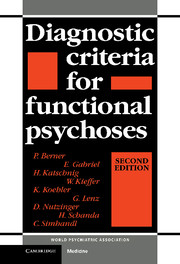C - Affective psychoses
Published online by Cambridge University Press: 07 September 2010
Summary
The diagnostic criteria found in this section follow the same sequence as the section on schizophrenic psychoses. The problems posed by schizophrenia have apparently spurred the formation of theories to a greater extent than have those posed by the affective psychoses, judging from the quantity of explicit proposals devoted to each of the two themes in the literature. This discrepancy is reflected in the smaller number of systems (thirteen) for the diagnosis of affective psychoses which are presented here.
Of the classic authors in the field of psychiatry, we are presenting only Emil Kraepelin, because his immediate successors, who were included in Part B on schizophrenic psychoses, made no important contributions to the theme of this section. Next comes the International Classification of Diseases of the WHO, whose 8th and 9th revisions, in contrast to schizophrenia, are not identical, and whose April 1989 draft for the 10th revision may well be definitive with respect to functional psychoses. The three interrelated American diagnostic systems follow: first the St Louis criteria by Feighner et al. (1972) then, issued from them, the research diagnostic criteria by Spitzer et al. (1978a, b).
Both these latter systems form the basis of the diagnostic and statistical manual, third edition (DSM–III) of the American Psychiatric Association, which finds comparison with its successor, DSM–III–R. Next come the relevant categories from the PSE/CATEGO system by Wing et al. (1974), the Vienna research criteria by Berner and the definitions by Taylor and Abrams. The Newcastle scales make their début for reasons stated in the Introduction (see Part A).
- Type
- Chapter
- Information
- Publisher: Cambridge University PressPrint publication year: 1992

